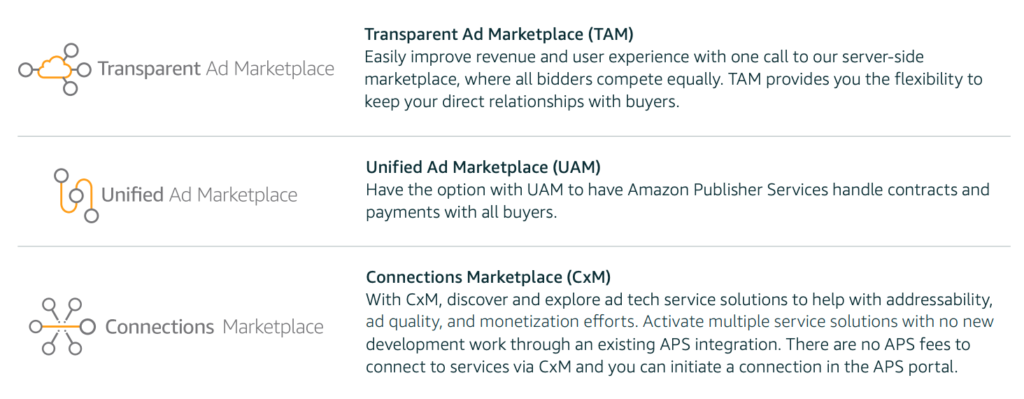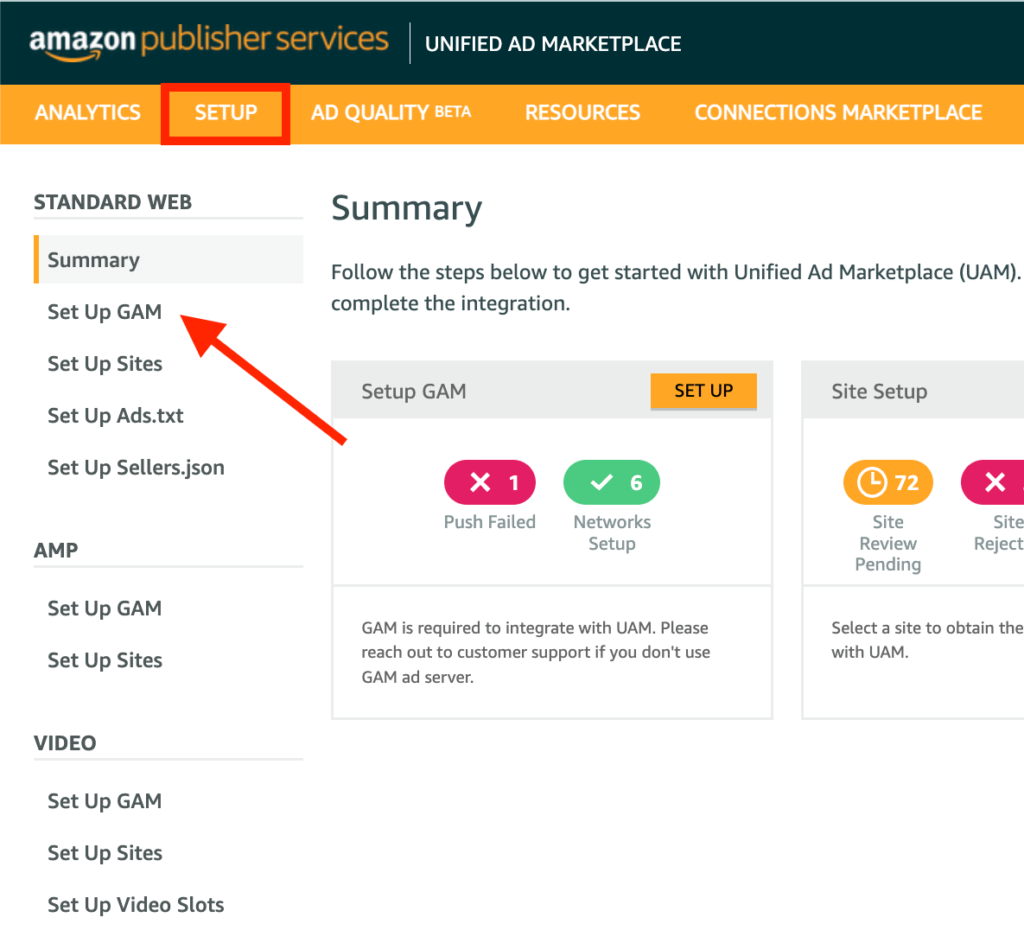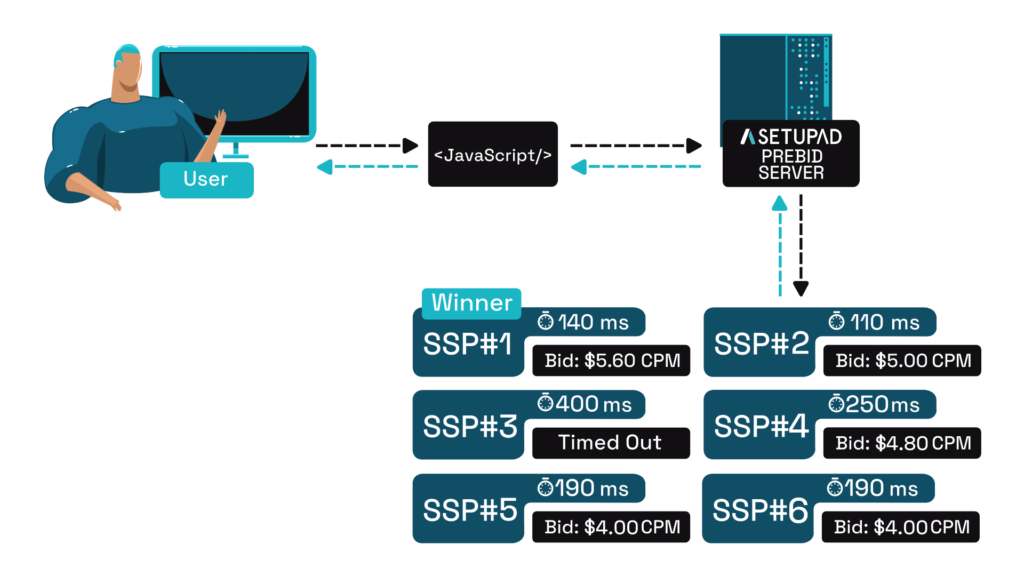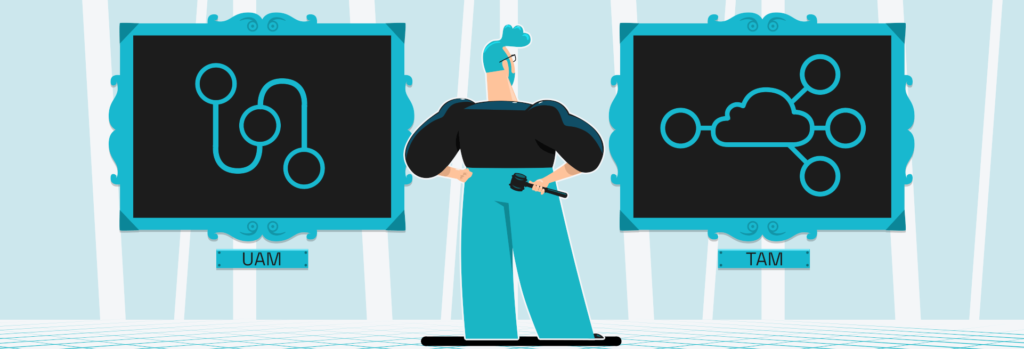A Guide to Amazon Publisher Services: UAM and TAM
Amazon Publisher Services (APS) are disrupting the header bidding market. APS offers two main solutions–Unified Ad Marketplace (UAM) and Transparent Ad Marketplace (TAM).
Both UAM and TAM are server-side header bidding solutions. Therefore, both have benefits and drawbacks compared to the client-side header bidding solution.
This article will explain what APS is, what it offers, and which is the best header bidding solution for different publishers.
What are Amazon Publisher Services?
Amazon Publisher Services (APS) is the platform for all of Amazon’s marketing services, which help publishers to create, maintain and grow their digital media businesses.
APS offers 3 primary services:
- Transparent Ad Marketplace (TAM).
- Unified Ad Marketplace (UAM).
- Connections Marketplace.

Source: APS
Header bidding services are utilized by both TAM and UAM.
With the help of header bidding, a publisher can make their inventory of ad spots available to multiple ad exchanges simultaneously so they can compete for them.
These services enable publishers to increase revenue and identify the most efficient advertising tactics with a single call to Amazon’s cloud-based marketplace.
- What is Connections Marketplace?
Connections Marketplace is a service marketplace where publishers can quickly review and test vendors across key categories (e.g., creative formats, advertising identity, and creative quality), which can help publishers to improve their ad stack and user experience.
There are no APS fees to use Connections Marketplace. But, depending on the service, some vendors may charge their fees.
Differences between APS, Open Bidding, and Prebid
Publishers can test a wide range of header bidding wrappers, including APS, Open Bidding, Prebid, and many others.
Most have concluded that more possibilities are better if they don’t overburden their client-side auction with exchanges or timeouts.
Some technologies integrate more seamlessly than others. For example, an exchange that performs better than its competitors and has a high match rate with Google may increase its market share, but an exchange that can return bids to TAM the quickest can profit there.
- What is Google Open Bidding?
Open Bidding is Google’s server-side header bidding solution. Through the server-side unified auction, multiple SSPs and ad exchanges can compete with Google’s ad exchange (AdX).
Open Bidding allows publishers to invite multiple third-party ad exchanges in an auction for their ad inventory.
The auction takes place in the ad server instead of the user’s browser. This increases the page loading speed, which is crucial for both the user experience and Google’s Core Web Vitals score.
To use Open Bidding, you must have access to Google Ad Manager (GAM) and a personal AdX account.
The publisher and the active SSPs can reach a revenue-sharing arrangement. Meaning that Google takes a cut from the SSP instead of the publisher. There is no direct expense to the publisher using Open Bidding.
- What is Prebid?
Prebid is an open-source header bidding solution that allows publishers to offer their ad inventory to multiple demand sources simultaneously. It provides both a client-side (Prebid.js) and server-side solution (Prebid Server).
Prebid has the advantage that any publisher can download Prebid’s wrapper code and begin plugging in demand partners.
One thing that differentiates Prebid from APS and Open Bidding is that it’s not a managed service.
Prebid is an open-source project that provides publishers with the technological infrastructure to operate header bidding. The implementation process is up to the publisher or his AdOps team.
How to Get Started With Amazon’s Programmatic Advertising Solution?
APS is primarily suitable for medium to large-sized publishers. Amazon does not work with new and small publishers, and they haven’t expressed any interest in doing so.
Small publishers should search for monetization of their web content elsewhere. For example, partner with a monetization platform like Setupad and get access to 28+ premium SSPs and Google AdX.
One of the most significant benefits of APS is that publishers can also have Amazon as a bidder.
As already mentioned, TAM targets larger enterprise publishers, while UAM is for medium-sized publishers.
The main difference between Amazon UAM and TAM revolves around how each handles SSPs for publishers.
With TAM, APS assumes the publisher is large, has established enough individual relationships with SSPs, and simply seeks to centralize bidding programmatically in their ad marketplace.
Users of UAM get access to both Amazon ads for publishers and a host of SSPs who work with Amazon, allowing Amazon to manage all the relationships between the SSPs and the publisher.
- How do publishers get into Amazon programmatic advertising?
Publishers can enter Amazon’s programmatic advertising through TAM or UAM. Each has its advantages and disadvantages (we’ll go into more detail below).
To begin working with APS, you must fill out their Contact Form. Afterwards, an Amazon representative will contact you. Smaller and medium-sized publishers will need a personal invitation from Amazon to participate in APS.
For larger publishers, getting started with APS is pretty straightforward. You’re good to go if you’re set up for header bidding and have existing relationships with your demand partners.
What is Unified Ad Marketplace (UAM)?
Amazon’s Unified Ad Marketplace (UAM) is a server-side header bidding wrapper. Instead of taking place within users’ browsers, the header bidding auctions are carried out on Amazon’s servers.
Additionally, UAM serves a variety of ad formats, such as:
- Desktop: 728×90, 300×250, 160×600, 300×600, 970×250
- Mobile Web: 300×250, 320×50
- Tablet Web: 728×90, 300×250, 160×600, 300×600, 970×250
Unified Ad Marketplace Pros and Cons
| Unified Ad Marketplace (UAM) | |
| Pros | • Managed service. Using a managed wrapper saves time and resources since constructing a header bidding wrapper is time-consuming and resource-intensive. • Demand expansion. Curating linkages between direct demand might take time and effort. You may scale demand and accelerate your revenue potential with an ad tech partner like Setupad, which provides access to several SSPs, including Amazon. • Page latency. Since the auctions are conducted outside the users’ browsers, using a server-side header bidding solution has a relatively low impact on page latency compared to client-side header bidding. • Integration with the current HB setup. The publisher’s current header bidding setup is not disrupted by UAM header bidding integration. Additionally, the integration increases publishers’ revenue. • Unified payments. On a Net-60 basis, Amazon combines your earnings from all activated SSPs (including their bidders) and sends you a single payment. • Revenue boost. Increased demand in your stack has two advantages for your revenue. First, more bids compete for your ad impressions to increase yield at the impression level. Second, it encourages demand partners to raise their offers to compete. |
| Cons | • Reporting. UAM provides simple filtering capabilities and data for reporting, such as bid requests, impressions, and revenue. However, this data is not very granular and detailed. • Transparency. Server-side auctions operate as a mystery. Access to Amazon’s auction mechanism and bid-level transaction data is restricted. • Complexity. One header bidding wrapper, like Prebid, requires significant setup and management. If you want to run client-side and server-side wrappers simultaneously, you’ll need to invest a lot of time in setting them up and constantly checking to ensure the auctions are functioning correctly. |
UAM helps small to medium size publishers monetize their websites with Amazon product ads and alternative demand from different SSPs, such as Pubmatic, OpenX, Xandr, etc.
Publishers who need access to SSPs and want a managed solution should use UAM.
How to integrate UAM with GAM?
Here are 4 steps to integrate UAM with GAM:
- Go to your UAM account.
- Click on “Setup” and then “Set Up GAM”

- Click on “Add New GAM Account” and follow the instructions for connecting UAM and Ad Manager if you are only integrating your website with UAM.

- Locate the JavaScript that has to be copied and pasted into your site’s header by going to “Resources” then “Add JavaScript” and finally “Integrate UAM alone.”
What is Transparent Ad Marketplace (TAM)?
Transparent Ad Marketplace (TAM) is Amazon’s server-side header bidding solution for enterprise publishers with large exchanges. It’s an invitation-only solution.
Publishers who use TAM must have direct agreements with SSPs like Amazon and manage the setup independently. The various bidders’ payments are also handled individually.
To use TAM, the only technical requirement is the active integration of the APS multi-slot header bidding tag. Publishers also require a written agreement with any demand partners they wish to work with.
Transparent Ad Marketplace (TAM) Pros and Cons
| Transparent Ad Marketplace (TAM) | |
| Pros | • No fees. Enterprise publishers who deal with TAM do not have to pay any fees. • Demand. In addition to your current SSP partners, you get access to Amazon’s demand. • Transparency in reporting. TAM users that use auction-level reporting (who is bidding and winning) get access to more data. • Control. Compared to UAM, you have more control over TAM’s implementation because the publisher is the sole owner of all your SSP contracts and must set them up yourself. |
| Cons | • Multiple payments. Rather than receiving a single payment from Amazon, you receive payments from each SSP under your arrangements. • Implementation. You must have the resources and expertise to manage the whole technical setup for a new server-side header bidding wrapper. • Demand reach. You must have contractual agreements with SSPs to access them through TAM. If you don’t, you might only have a small amount of demand. |
TAM is designed for large publishers with established direct demand relationships.
While working with TAM, you enter into direct agreements with SSPs and are responsible for the setup and optimization. You must handle each SSP separately.
UAM vs. TAM
Both TAM and UAM are server-side header bidding solutions. Therefore, auctions take place on the server, not the browser.
While UAM helps small to medium-sized publishers to access and maintain connections with SSPs, TAM is used by larger enterprise publishers who already have agreements with SSPs and want to centralize their bids.
With UAM, Amazon acts as a middleman for publishers and demand partners. To bring demand partners to bid on your ad inventories, Amazon will get in touch with the SSPs.
With TAM, Amazon contributes as a demand partner. Publishers can contact Amazon or connect with SSPs directly. TAM is not a managed service. Therefore, publishers will need to take care of the header bidding’s technical integration, including the setup and optimization.
Simply put, publishers who need access to SSPs and want a managed solution should use UAM. On the other hand, TAM is intended for larger publishers with established direct demand connections.
This difference is further reflected in how Amazon handles payments.
Publishers using TAM get paid separately by SSPs they have contracts with and by APS for Amazon demand.
On the other hand, publishers using UAM receive combined monthly payments from APS.
Simply put, there are 3 main differences between the two:
- Centralization. UAM brings all parties together in a centralized location, making it easier for buyers and sellers to connect and transact. TAM may not be centralized but instead aims to provide transparency and visibility into the advertising transactions that are taking place.
- Information availability. With UAM, information about ad transactions may only be available to some parties. TAM provides full transparency into all aspects of the transactions, including details about the ad inventory, prices, and terms.
- Goal. UAM streamlines buying and selling of ads and makes it more efficient for both parties. TAM provides greater visibility and accountability in the ad industry, ensuring that all parties are treated fairly and transparently.
Overall, both types can help improve the ad industry’s efficiency and effectiveness, but they do so in different ways.
| Unified Ad Marketplace | Transparent Ad Marketplace | |
| Publisher size | Small to medium | Large |
| Agreements | Publishers sign one click-through contract with Amazon, and Amazon signs contracts with SSPs. | Publishers sign contracts directly with each SSP and also with Amazon. |
| Fee | 10% transaction fee from SSP’s bid price | No fee |
| Demand | 20+ SSPs | 20+ SSPs |
| Ad formats | Desktop, Mobile (Web), Tablet (Web) | Video (pre-roll) for desktop and mobile, dynamic display |
| Transparency | Less | More |
Server-side vs. Client-side vs. Hybrid Header Bidding Explained
With client-side header bidding, also known as browser-side header bidding, the real-time header bidding auction takes place in the user’s web browser (e.g., Google Chrome).
For this technology to work, publishers must add Prebid JavaScript (JS) code into the website’s source code. When the prebid JS code executes, the user’s browser sends many ad requests to demand partners participating in the auction where the highest bidder wins.
The server-side header bidding concept is similar to the client-side header bidding.
Instead of sending many ad requests and holding header bidding auctions in the user’s web browser, the user sends a single request to the server, which sends out many requests to SSPs/ad exchanges.
All bidders respond almost immediately without the involvement of the user’s browser.

By utilizing a hybrid header bidding, publishers can benefit from client-side and server-side header bidding.
The list of demand sources with lesser performance competes on the server side, while the best-performing SSPs and ad exchanges operate on the client side.
The hybrid method sends calls to the user’s browser and an external server and then picks the winning bid from both auctions.
Therefore, advertisers can still bid based on a user’s cookies from the client side while enjoying the speed and increased bids from the server side.
It enables increased fill rates and higher CPMs, as there is more advertiser competition and faster loading times without losing user data.
In general, hybrid header bidding reduces page load times and the amount of processing power needed by the user’s browser while enabling publishers to connect to more advertising demand sources.
Since the bids are typically cheaper for demand partners with broad advertising goals like brand recognition, the server-side works well for them.
The client-side works better for demand partners who want to target audiences and raise bids using specific data like cookies and visitor profiles.
What are the pros and cons of server-side and client-side header bidding?
| PROS | CONS | |
| SERVER-SIDE | • Minimal impact on website’s loading speed • Reduced page latency • Better ad viewability • Better fill rate • More demand partners can be added • Higher CPM • Better for rich media and video ads as these are the heaviest ads that take the toll on the website loading speed. • Fewer timeouts | • Lower cookie matching rate • It’s complicated and costly if done by yourself |
| CLIENT-SIDE | • Cookie Matching • Control of adding and removing the buyers • Easy to implement and the first choice for most publishers | • Limited amount of demand partners can be added • Higher page latency • Fewer bids • Higher page loading speed |
You as a publisher should test them out and evaluate the outcomes. Afterward, you can find the answer to which is preferable in the data produced by the results.
Setupad’s Header Bidding Solution for publishers
Setupad’s header bidding wrapper is hybrid as it combines the most valuable bids on the client side with bidding on the server side. That way, publishers get the most revenue without compromising speed.
Setupad’s header bidding includes server-to-server (S2S) connections to Prebid.js server, Google’s Open Bidding, and Amazon Transparent Marketplace (TAM). Overall, these S2S integrations account for 35% of the winning auctions.
Setupad provides a simple and easy ad tag implementation, high-quality ads from premium demand partners, and predefined blocklists by default to avoid unwanted and low-quality ads.
For a simpler and more efficient header bidding solution, publishers should partner up with a monetization platform. This will ensure an advanced technology suite, programmatic expertise, and individual approach.
If you want to test our solution, sign up or contact us at [email protected].


